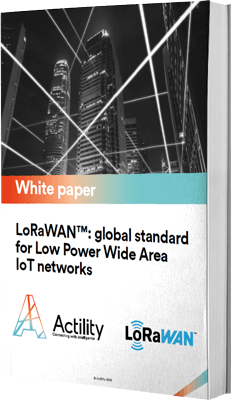French firm Actility, founded by technology entrepreneur Olivier Hersent in 2010, is one of the biggest advocates of LoRA technology to enable Low Power Wide Area (LPWA) networks, and is also a founding member of the LoRA Alliance, which is rapidly growing in both size and reputation.
The company last year secured $25 million funding from large scale operators KPN, Orange, Swisscom and Foxconn, intended to accelerate its launch of ThingPark, its open standard IoT network solution.
This serves as the company’s primary product, which is designed for IoT deployments of various sizes, from single enterprises through to smart cities. ThingPark aims to work with low power devices, and provide the connectivity at low cost.
Now, as interest in the LPWA market begins to ramp up, with rival proprietary LPWA solutions emerging on the market from Sigfox and Ingenu, and the pending release of 3GPP-backed NB-IoT standards, Actility has opted to appoint telecoms and technology industry veteran Mike Mulica to lead it towards its next stage of growth.
Mulica, who has held leadership roles with Phone.com, Syncronoss and Real Networks, told Mobile World Live it was clear to him, upon meeting Hersent, that LPWA was really going to take off in the second half of the year, and joining Actility was an opportunity he could not turn down.
In this interview, he opens up on some of the challenges vendors may face in accommodating IoT networks, which could prove to be a “very low cost market” to run, his open approach to competition, and his thoughts on why LoRa technology could be likened to an Android ecosystem.
MWL: What is your view of LPWA and Actility’s journey so far?
Mulica: LPWA has become the rage over the course of the past year in terms of its ability to economically connect many things, and capture and deliver data to those things that wasn’t possible before.
These extremely low levels of economics are produced into the system, so the folks here built an end to end platform that includes the radio layer and the mash up layer, allowing for the connection of all kinds of things and the capture of data from many different applications. This marketplace allows vendors to deliver their sensors and applications into the markets where the networks exist.
Actility itself is now on an open systems march towards LPWA and making that pervasive. The first couple of years have been about building out networks to make sure there is coverage and the first network technology available in this category was LoRa.
To that end, we have six nationwide deployments globally, with many more planned. This also consists of deployments planned in Asia, that will be announced in a couple of weeks and many planned in Europe, with a whole lot going on in North America that should also get announced in the next month or so.
In any event, the idea here is to be a LPWA technology company to embrace many, or even all, radio frequency technologies when they come to market.
MWL: The LoRa Alliance has had some high profile backing from some large scale operators in recent weeks. Where does a small player like Actility fit into that ecosystem?
Mulica: We were one of the co-founders of the LoRa alliance with IBM and SemTech, so, from a strategy stand point, we have invested a lot of time in terms of technical leadership and co-chaired many of the committees around its development. I think we are at 330 members of the alliance now and it is growing fast. The nice thing about it is the fact it operates a structure that’s very open so there can be a lot of different participants at every layer of technology, making it a very accessible market to join. Now, we have big companies like Orange also on board, and Cisco is a large partner of ours from a distribution standpoint, which makes them involved too. It’s got a lot of momentum behind it.
MWL: How will Actility respond to NB-IoT standards from 3GPP, and what is your view on some of the other proprietary LPWA technologies on the market?
Mulica: We will embrace NarrowBand IoT from 3GPP. It is part of our roadmap and we will deliver a NB-IoT capable product as soon as the standards are ratified. It’s been in development and we are excited about that aspect of our product.
We also think there are lots of things that are complimentary about the different radio technologies, and when they come together in the portfolio they are better. At the end of the day, it’s not about the radio technology, as most of these connections are low cost connections, and there’s got to be many, many millions of them happening.
We think the key is creating an environment where it is really easy to connect something and make it happen in a low cost, automated way. There is now a seamless marketplace of having things that are built in an aging territory that might have a particular need for connecting to a certain object.
Radio settings can be seamless and easy to do, similar to the way the internet works. We actually see this as like the internet, and you can plug into the internet in many different ways, through your Ethernet cable or your Wi-Fi modem, it’s sort of irrelevant the way you do it. The real value is in making the ecosystem work in the best possible way.
MWL: So you don’t see rival technologies clashing?
Mulica: I think there are clearly going to be different vendors, but this will be a very low cost market. Many of the vendors that have built up the mobile networks in the past and built that marketplace need to understand this is a different paradigm in terms of the value of the network and the cost of the network – and it may be difficult for them to adjust to this different cost basis.
It’s sort of classic evolution, it’s hard to do the next thing when you became used to the last market.
MWL: Are you not at all concerned by competition from rival players like Sigfox for example?
I see it as a positive, it’s good to have funding into this marketplace in a big way and they’ve had great backing, so they are able to be aggressive and raise awareness from an ecosystem perspective of what low power wide area can do and the impact it can have.
In any case, it’s always good to have someone you can compare yourself against, as we are also well funded and it’s a big world. There are even certain aspects of some of the closed technologies that we like, so our strategy from a technology perspective is to be all inclusive.
We are the type of company that is very ecosystem friendly so it’s easy to be a participant at every layer of the market with us – whether you want to be a component supplier or a base station supplier, an operator or an application supplier, there is a lot of entry into those layers and this creates an exponential effect on the amount of R&D we can do.
It’s very difficult to be a vertically integrated company, which makes them a bit more like Apple in their vertically integrated form, while we operate an open ecosystem form, which makes us a bit more like Android, but it’s good to have alternatives.
MWL: What is your vision for growth at Actility?
Mulica: We are growing fast and part of that will be to secure more capital to ensure we are in the position in the market that we want to be in. We are in pole position and we want to maintain it. It is crazy from a growth standpoint and we need capital consistent with that growth to be able to capitalise on the market opportunity.
MWL: What encouraged you to take the role?
Mulica: My background is mobile, internet, cloud and I probably age myself a little when I say I was in Chicago when Motorola introduced the first mobile phone, and I helped them roll out the first mobile networks of the world. But I’ve always really been focused on reaching markets that will grow globally, and Actility has already done such a great job in getting into this market, deploying its network and getting up and running.
This clearly isn’t just a science project and it looks like the market will really take off in the second half 2016.
Inscrivez-vous à notre webinaire :
Nouvelle étape dans l’intégration des services urbains via LoRaWAN®
28 novembre 2024 – 10:00 (CET)







Learn more about the LoRaWAN technology by downloading the Actility “What is LoRaWAN” white paper